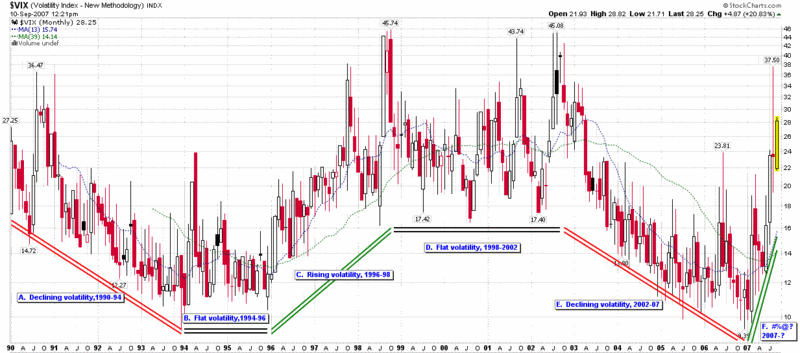On my very first post in this blog, I offered a monthly chart of the VIX from 1993 to January 2007 and identified what I called four VIX macro-periods as follows:
- relatively low, flat volatility for 3 years from 1/93 to 1/96
- increasing volatility for 1 ¾ years from 1/96 to 9/97
- a five year period of extreme volatility from 9/97 to 9/02
- the current period of decreasing volatility that began in 4/02 and continues to the present
Now that I have more familiarity with StockCharts, I have updated that chart to reflect the full range of monthly VIX candlesticks from the first official CBOE data in January 1990 to the present. Adding one macro-period to the beginning and end of the original VIX chart, I now have six VIX macro cycles. Ironically, the current period starts just about the same time I started this blog.
A couple of comments on the VIX macro cycle graphic below:
- This model is a work in progress, even though I like the way it reads at present
- 2-4 year cycles appear to be the norm (I had earlier favored 3-5 year cycles)
- The slope of the current macro cycle is unprecedented for the time periods considered
- The gap between the current monthly candle and the moving averages is also unprecedented
Going forward, I will have a lot more to say about my VIX macro cycle idea, long-term VIX moving averages, and long-term VIX forecasts.
[One quick note on the ‘methodology’ used above. As this chart is more art than science, you could certainly make an argument, as I did the last time around, that the transition from C to D happened in October 1997 instead of October 1998. Frankly, I think either interpretation is correct and does not materially affect any long-term view of the macro cycles.]

do you find any correlation between VIX and $IRX or $TNX?
ReplyDeleteGood question. I do see a fairly strong correlation between the VIX and bonds, but one which waxes and wanes at various periods. My guess is that fear and a 'flight to quality' are highly correlated, which is part of the reason, but I will delve into this at some point on the blog.
ReplyDeleteCheers,
-Bill
Great Blog...thanks for the info
ReplyDelete